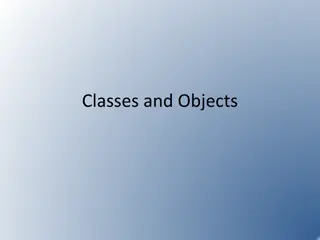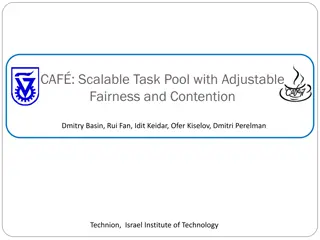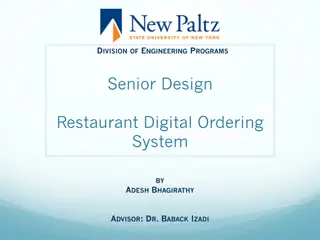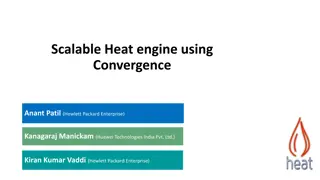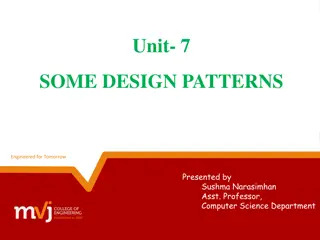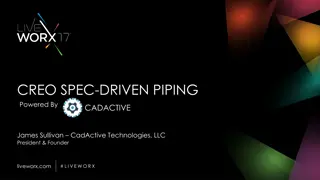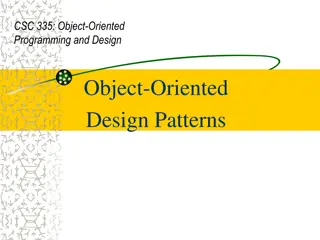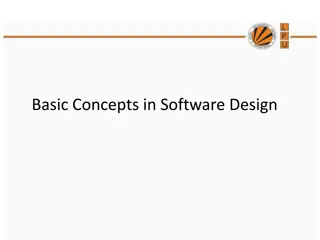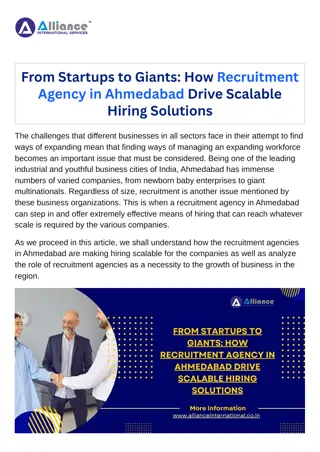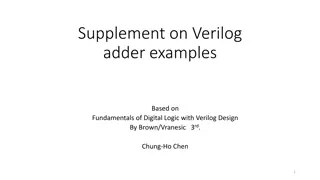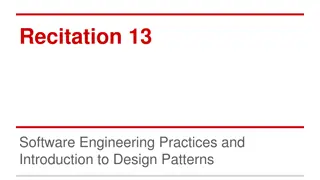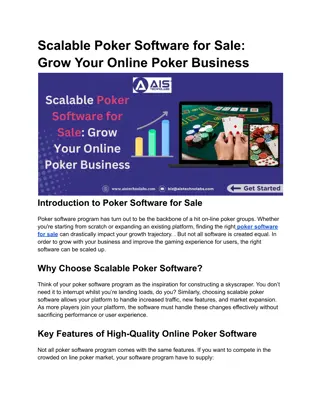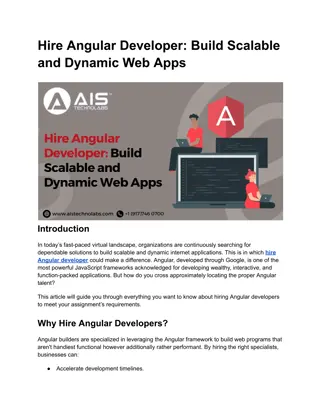Sustainable Solutions for Ending Plastic Waste through Technology and Innovation
Technology, Innovation, and Design Working Group led by Sanjeev Raghubir focuses on collaborative efforts to end plastic waste in South Africa by developing scalable solutions across the plastic packaging value chain. The group aims to achieve zero plastic waste in the environment through increased
4 views • 6 slides
Guidelines for Design of Cement Concrete Pavement and Interlocking Paver Blocks
This document provides guidelines for designing cement concrete pavements and interlocking paver blocks, covering factors governing design, wheel loads, design period, subgrade characteristics, approximate k values based on CBR values, and the importance of a sub-base below concrete pavements. It em
0 views • 67 slides
Object-Oriented Design in Software Development
Learn about the concept of object-oriented design in software development, including the importance of design, the structure of objects, building objects, and what a class typically looks like. Discover how design facilitates building scalable systems and fostering collaboration within development t
1 views • 21 slides
Software Engineering Design Principles and Concepts
The chapter discusses the essential principles and concepts in software design, highlighting the four key design models - data design, architectural design, interface design, and component-level design. It emphasizes the importance of traceability to the analysis model, minimizing the gap between so
2 views • 36 slides
Scalable Task Pool with Adjustable Fairness
Explore CAF, a scalable task pool with adjustable fairness and contention, offering a solution to the inherent scalability problems of FIFO queues. The system allows for control over the level of relaxation, providing more fairness or less contention as needed. With a focus on bounded non-FIFO pools
5 views • 26 slides
Scalable Causal Consistency for Wide-Area Storage with COPS
This paper delves into the importance of scalable causal consistency for wide-area storage with the COPS system. It explores desired properties such as availability, low latency, partition tolerance, and scalability within data centers. The document discusses the challenges of achieving consistency
0 views • 41 slides
Senior Design Project: Restaurant Digital Ordering System by Adesh Bhagirathy
This senior design project by Adesh Bhagirathy focuses on developing a digital ordering system for restaurants to offer online ordering to their customers. The project aims to address issues in the current restaurant landscape, provide low-cost solutions, promote restaurant brands, and offer fully m
0 views • 39 slides
Overview of Scalable Heat Engine using Convergence
Anant Patil and Kanagaraj Manickam discuss a scalable heat engine using convergence architecture, offering insights into design evolution, comparison, and progress. The presentation covers an orchestration service to manage cloud applications, including modeling, deployment, scalability, configurati
0 views • 33 slides
Distributed Solvers for Scalable Computing in UG
This project discusses the use of distributed solvers in UG to enable multi-rank MPI-based solvers with varying sizes, addressing the need for scalable solver codes and dynamic resource allocation. It introduces the UG solver interface, revisits the Concorde solver for TSP problems, and explores run
0 views • 14 slides
Design Patterns for Software Development
Explore the world of design patterns in software development, including structural decomposition, organization of work, access control, and communication patterns. Learn the differences between design and architectural patterns, and how they influence software systems. Discover categories of design
3 views • 107 slides
Chi: A Scalable and Programmable Control Plane for Distributed Stream Processing
Distributed stream processing systems are increasingly crucial for various production use cases, such as real-time dashboards, machine learning, and interactive debugging. The challenges of handling large variability in production ingestion workloads and high-degree data skew in queries are addresse
1 views • 20 slides
Design Inspiration and Elements in Costume and Fashion Design
Dive into the world of costume and fashion design through a visual journey of finding design inspiration, understanding the design process, emphasizing originality, and exploring different sources of creativity. Discover how technology, art, food, history, architecture, and nature can spark innovati
0 views • 45 slides
Enhancing Piping Design Efficiency with Spec-Driven Technology
Explore how Spec-Driven Piping technology powered by CADACTIVE offers a standardized approach for piping design in Creo Parametric. This innovative extension streamlines design communication, eliminates errors, and improves design efficiency by utilizing a master catalog, automated checking capabili
0 views • 15 slides
Material Design: Combining Classic Design Principles with Technological Innovation
Material Design is a design language that combines traditional design principles with the possibilities offered by technology and science. It emphasizes visual language, classic design elements, and innovation to create delightful user experiences. The Material Metaphor, Imagery, Typography, Color,
0 views • 34 slides
Comprehensive Guide to System Design Components and Techniques
System design involves the detailed planning and identification of components in an information system, aiming to provide users with a general understanding of the new system. This process includes techniques like flowcharts, prototyping, and component design, covering aspects such as output design,
0 views • 24 slides
Overview of Object-Oriented Design Patterns in Software Development
In the realm of software development, object-oriented design patterns play a crucial role in structuring code and solving recurring problems efficiently. These patterns, as outlined in various influential books and resources, provide a systematic approach to design, encompassing aspects like object
0 views • 26 slides
Basic Concepts in Software Design
Software design involves transforming customer requirements into a form suitable for implementation, with activities categorized into preliminary and detailed design stages. High-level design focuses on module identification and control relationships, while detailed design entails defining data stru
1 views • 24 slides
LD-Sketch: Distributed Sketching Design for Anomaly Detection in Network Data Streams
LD-Sketch is a novel distributed sketching design for accurate and scalable anomaly detection in network data streams, addressing challenges such as tracking heavy keys in real-time across a vast key space. By combining high accuracy, speed, and low space complexity, LD-Sketch enables efficient heav
0 views • 25 slides
From Startups to Giants How Recruitment Agency in Ahmedabad Drive Scalable Hiring Solutions
Recruitment agencies in Ahmedabad offer scalable hiring solutions, leveraging local talent expertise and advanced technology to ensure efficient and flexible recruitment for businesses of all sizes. For more information visit: \/recruitment-consulta
0 views • 6 slides
SEAL: Scalable Memory Fabric for Silicon Interposer-Based Systems
SEAL lab focuses on designing a scalable hybrid memory fabric for silicon interposer-based multi-core systems to support memory-intensive applications like in-memory computing. The lab's research aims to provide low-latency, high-bandwidth processor-memory communication through innovative topology,
0 views • 27 slides
Proxies, Caches, and Scalable Software Architectures
Statelessness, proxies, and caches play key roles in creating scalable software architectures. The lecture explains the concepts of proxies and caches, highlighting their functions in enhancing performance and scalability. Proxies act as intermediaries for requests, while caches store frequently acc
0 views • 13 slides
SE2811 Software Component Design Overview
This course covers software component design, design patterns, object-oriented design, algorithms, and opportunities for reuse in systems design. It emphasizes the importance of domain-level design and provides insights into solving core problems through reusable classes.
1 views • 21 slides
Input Elimination Transformations for Scalable Verification and Trace Reconstruction
This work introduces new input elimination techniques for scalable model checking in industrial applications, focusing on trace reconstruction. The transformations aim to make the netlist more tractable for solving, involving various algorithms such as retiming, phase abstraction, and bitwidth reduc
1 views • 27 slides
Analysis of Bunch Lengthening in CEPC for Different Design Parameters
This study explores bunch lengthening in the Circular Electron Positron Collider (CEPC) for various design parameters, analyzing a 54 km design scheme, a 61 km design scheme, and a 100 km design scheme. The analysis includes the theoretical framework used, equations for bunch lengthening, and conclu
1 views • 15 slides
Scalable Query System for Complex Game Environments Evaluation
Designing a scalable query system for evaluating complex game environments involves key elements like defining required features, structuring query elements, and understanding function models for optimal performance. The system must be customizable, support debugging, and allow runtime parameter adj
0 views • 41 slides
Verilog Adder Examples & Typical IC Design Flow
This comprehensive content delves into Verilog adder examples, typical IC design flow, physical design considerations, and examples of OpenGL ES GPU and ARM hypervisor applications. It covers the fundamentals of digital logic with Verilog design, hardware description language, FPGA prototyping, phys
1 views • 27 slides
Scalable Identity and Key Management for Publish-Subscribe Protocols
This research by Prashant Anantharaman from Dartmouth College focuses on scalable identity and key management for publish-subscribe protocols in Energy Delivery Systems. It discusses the architecture, goals, assumptions, and implementation results in the context of PKI vs. Macaroons protocols. The w
0 views • 37 slides
Scalable Causal Consistency for Wide-Area Storage with COPS
This paper discusses the implementation of scalable causal consistency in wide-area storage systems using COPS. It delves into the key-value abstraction, wide-area storage capabilities, desired properties such as ALPS, scalability improvements, and the importance of consistency in operations. Variou
0 views • 42 slides
Best Practices in Software Engineering: Design Patterns and Code Clarity
Software development can be chaotic, but by focusing on code clarity, adopting bug-avoidance practices, utilizing design patterns, and employing good coding strategies, engineers can create maintainable and scalable code. Methods with clear purposes and wrapper methods for readability, along with th
0 views • 37 slides
Simplify Label Design with Label.Cloud
Label.Cloud is the easiest cloud-based solution for designing and printing labels. NiceLabel's Label.Cloud offers comprehensive label management, allowing businesses to create, store, and print labels efficiently. Key benefits include quick setup, remote design capabilities, secure cloud storage, se
0 views • 14 slides
Scalable Poker Software for Sale_ Grow Your Online Poker Business
Discover scalable poker software for sale to grow your online poker business. Customize your platform with high-quality online poker software.\n\nSource>>\/\/ \/poker-software-for-sale\n
0 views • 4 slides
TheSMSPoint OTP SMS Solutions. Secure, Reliable, and Scalable Authentication via
Ensure secure user verification with TheSMSPoint's OTP SMS Solutions. Delivering time-sensitive one-time passwords directly to users' mobile devices, our service provides fast, reliable, and scalable authentication to protect against unauthorized acc
0 views • 8 slides
Ligands for Nanoparticle Surface Effects
Design and Synthesis of Ligands for studying Nanoparticle Surface Charge and Distribution, including examples of monomeric and polymeric ligands. Critical design elements of the ligand library are discussed, emphasizing scalable synthesis and key features. Initial synthesis challenges are noted, wit
0 views • 14 slides
Efficient Network Design with Variable Length Subnet Mask
Variable-Length Subnet Masking (VLSM) offers a more efficient way of subnetting a network compared to classical subnetting. By using different subnet masks for different networks, VLSM allows for a more optimal utilization of IP addresses. This involves determining the number of host bits needed for
0 views • 15 slides
Scalable Cryptographic Authentication for High Performance Computing
This work discusses the scalable cryptographic authentication approach developed by Andrew Prout and team for high-performance computing. The LLGrid system architecture, challenges with interactive supercomputing, and utilization of LLGrid for various computing tasks are explored, highlighting the i
0 views • 34 slides
Why Are RPO Companies in India Critical for Scalable Recruitment
Understand the importance of RPO companies in India for scalable recruitment. Explore how they provide flexible, efficient, and cost-effective hiring solutions to support business growth. For more information, visit: \/rpo-companies.
0 views • 4 slides
Hire Angular Developer_ Build Scalable and Dynamic Web Apps
Looking to hire Angular developers? Build scalable & dynamic web apps. Hire AngularJS developers, programmers, or Angular developers in India. Contact AIS Technolabs.\n\nsource>>\/\/ \/hire-php-developers\n
0 views • 6 slides
E-commerce Development: Essential Tips for Building a Scalable Online Store
To build a scalable online store, focus on selecting a flexible e-commerce platform, ensuring mobile responsiveness, implementing secure payment gateways, optimizing site performance, and enhancing user experience. Prioritizing these elements fosters
0 views • 1 slides
E-commerce Development: Essential Tips for Building a Scalable Online Store
To build a scalable online store, focus on selecting a flexible e-commerce platform, ensuring mobile responsiveness, implementing secure payment gateways, optimizing site performance, and enhancing user experience. Prioritizing these elements fosters
0 views • 11 slides
Why I Chose Scalable Technology Solutions for My Business Instead of Traditional IT Infrastructure.docx
Switching from traditional IT to scalable technology solutions transformed my business with cost savings, flexibility, and enhanced security for true growth.\n\n
0 views • 3 slides


